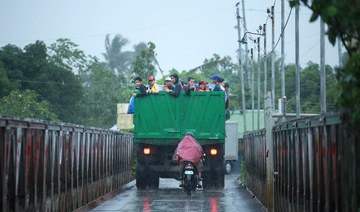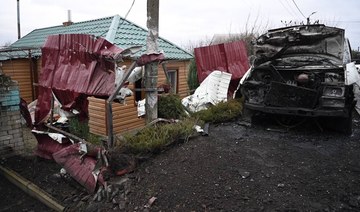MANILA: Eleven-year-old Jerry’s crime was breaking curfew laws after fleeing violence at home. His punishment? Being sent to a youth detention center, where he says he endured sexual abuse.
Officially called “Houses of Hope,” proponents in the Philippines say such facilities are places for reformation and education, but critics slam many of them as “hellholes” where children are treated like caged animals.
Rights’ groups say Jerry should never have been detained under current laws, but warn a proposed bill to lower the age of criminal responsibility from 15 to 12, will mean thousands more children will be sent to overcrowded and underfunded centers — leaving them vulnerable to mistreatment.
“I felt so dirty. That was the first time it happened to me,” Jerry told AFP as he recalled the night he was pulled from his bed, forced to the bathroom and attacked by older boys also held at a decaying center in Manila.
“I cannot forget the sexual abuse,” he explained, adding that he left home to escape beatings from his father and ended up sleeping on the streets. His mother works in Kuwait.
Under existing law, Houses of Hope are primarily to hold young offenders aged 15 to 18. But charities say younger vulnerable children from troubled homes, like Jerry, are sometimes swept up in the dragnet even for minor misdemeanours and struggle to recover from the experience.
Watchdogs and former wards warn planned legislation to criminalize children as young as 12 and then detain them with older teens and in some cases adults will put those least able to defend themselves at risk.
“There is a higher potential for abuse because the government is not prepared,” said Melanie Ramos-Llana of Child Rights Network Philippines.
“You put more children into Houses of Hope which are not equipped, lack personnel and programs, you will have problems. Jails or detention centers are not places for children,” she added.
Youth advocate Louise Suamen warns mixing youngsters who have committed minor infringements with older criminals could create a “school of crime.”
“If you are a child subjected to this environment, you can learn violence or abusive behavior. If they want to change something... treat detention as the last resort,” explained Suamen of Bahay Tuluyan Foundation.
A bill to give authorities the power to prosecute younger children stalled in the session of the legislature that wrapped up last month.
But it is a key plank of President Rodrigo Duterte’s tough-on-crime stance, which includes restoring the death penalty and his internationally condemned drug crackdown that has killed thousands since 2016.
After sweeping May’s midterm polls, Duterte allies dominate congress and have vowed to advance his agenda when the session opens on Monday.
But critics insist conditions in many of the facilities are identical to or worse than the jails adults are sent to.
“Children are detained in these so-called House of Hope like animals in cages,” said Father Shay Cullen, president of PREDA Foundation which helps boys like Jerry.
“These are really hellholes of subhuman conditions,” he added.
Five children previously held in the system, including Jerry, told AFP they suffered abuse in youth centers.
All the boys are identified using a pseudonym because they are minors or were when held.
Justin, who was 17 when he was brought to a youth center in the capital in 2017, said other boys beat him on the pretext he had broken house rules.
“They would punch us in the chest, stomach and sometimes the chin. It was so painful. I learned to be callous there because of what they did to me and I wanted revenge,” he said.
There are 55 government-run Houses of Hope nationwide, but this is well short of the 114 the Philippines has estimated it needs to properly house troubled juveniles.
According to official data only eight comply with social welfare rules.
These guidelines include having one social worker for every 25 children, providing one bed per resident along with nutritious meals, clothing, toiletries and rehabilitation programs.
“Some of the Houses of Hope we saw were worse than prisons. They have no programs,” Tricia Oco, executive director of the government’s Juvenile Justice and Welfare Council, told a senate inquiry in January.
Tristan, 15, was relieved when he was transferred to a House of Hope in Manila after being held in an adult jail on a drug trafficking charge he said police fabricated.
“I thought it would be a lovely home. But it was also a prison, a prison for children,” he told AFP.
The facilities where Jerry, Justin and Tristan stayed denied AFP’s requests for a visit.
The Department of Social Welfare and Development said it did not monitor peer abuse in centers, but institutions that failed to meet standards should be “held responsible.”
The Philippines raised the age of criminal responsibility from 9 to 15 in 2006, a move hailed as a step toward humane treatment.
However Duterte has repeatedly attacked the change as hampering police efforts to crack down on underage couriers for drug syndicates.
The gaps in the system stem from insufficient funding, weak congressional oversight and authorities’ preference for detention over community-based programs, advocates say.
“In reality detention becomes the first resort,” said Rowena Legaspi, executive director of the Children’s Legal Rights and Development Center.
The current law tasks provinces and cities with building and operating the centers but the national government monitors compliance.
Many Houses of Hope struggle with inadequate resources, said Jay Mark Chico, center head in northern Bulacan province.
His facility was built to accommodate 60 children but now houses 144 — squashed into rooms behind metal bars where some must sleep on the floor.
Chico told AFP the province had a daily food budget of 33 pesos (0.65 USD) per child but was pushing to increase this while building a bigger center to address overcrowding.
Still, there are some that say their time in the centers helped them.
“I am so grateful because I never imagined I could still pursue my studies,” said 21-year-old Nathan Andres, who was detained as a juvenile for rape but has been allowed to serve out his sentence in the Bulacan youth facility.
However Andres, who wants to become a teacher, says targeting 12-year-olds is not the answer.
He mused: “We are like the flowers we craft from old papers. People think we are garbage, useless. But actually we still have value.”
‘Worse than prison’: Abuses in Philippine youth homes
‘Worse than prison’: Abuses in Philippine youth homes
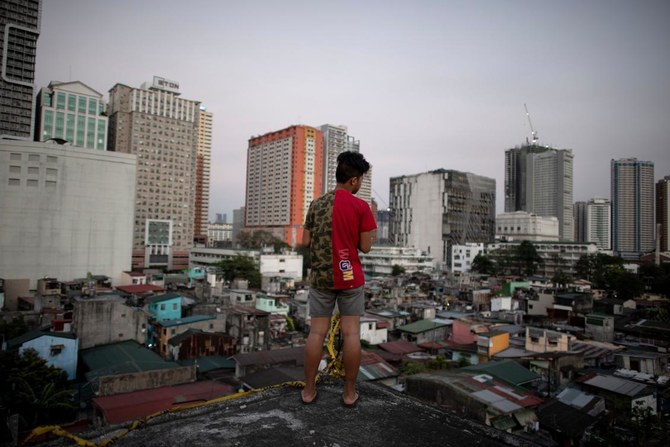
- Critics slam many of youth detention centers as “hellholes” where children are treated like caged animals
- A proposed bill will lower the age of criminal responsibility from 15 to 12
Man arrested after Denmark’s Billund Airport evacuated over bomb threat
COPENHAGEN: A man was arrested in Denmark on Saturday in connection with a bomb threat at Billund Airport, the country’s second largest aviation hub, police said in a statement.
The airport, in central western Denmark, was evacuated and remains shut following the threat.
“The evacuation has proceeded calmly and as expected, with travelers following our instructions,” police inspector Michael Weiss said in a statement.
Investigations into the incident are continuing, the police said, adding it was not clear when the airport would reopen.
Indonesia on highest alert as Sulawesi volcano continues to erupt

- Over 7,500 people living near the volcano have so far been evacuated
- Volcanic activity is common in Indonesia, which lies on the Pacific ‘Ring of Fire’
JAKARTA: Indonesian authorities were on the highest alert on Saturday as a volcano in North Sulawesi continued to erupt. Thousands living nearby have been forced to leave their homes.
Mount Ruang, located on the northern side of Sulawesi Island, had at least eight eruptions since April 16, including a major one on Wednesday evening, which prompted Indonesia’s volcanology agency to issue its highest alert, which indicates an active eruption.
The center recorded at least two eruptions on Saturday, with the crater emitting white-gray smoke more than 1,200 meters above its peak after midnight, followed by another eruption at noon that released an ash column of about 250 meters.
“Based on visual observations, as of April 20, 2024, at 12:15 p.m., there is still high volcanic activity in Mt. Ruang,” Muhammad Wafid, head of the geology department at the Ministry of Energy and Mineral Resources, said in a statement.
“The potential danger is an explosive eruption that may cause the mountain to spew volcanic rocks in different directions, followed by clouds, as well as effusive eruption, or lava flow.”
With authorities having established a six-kilometer exclusion zone around the volcano, around 7,500 people have so far been evacuated, including more than 1,500 residents who live on the smaller island where Mount Ruang stands, and around 6,000 people living on neighboring Tagulandang island, northeast of the volcano, according to the latest data from Indonesia’s National Disaster Mitigation Agency. Thousands more are still at risk.
The international airport in Manado city, less than 100 kilometers away from Mount Ruang, is closed until at least Sunday because of volcanic ash.
“There are still concerns, because tremors and volcanic earthquakes are still being recorded by our devices, indicating magmatic fluid supply is still moving from the depth to the surface,” Hendra Gunawan, who heads Indonesia’s volcanology agency, told Arab News.
“There’s still potential for more eruptions … And a tsunami may occur if there is a large flow of volcanic material into the sea.”
Indonesia, a vast archipelago nation, has around 120 active volcanoes. The country experiences frequent seismic and volcanic activity due to its location on the arc of volcanoes and fault lines in the Pacific Basin known as the “Ring of Fire.”
Moscow says 50 Ukrainian drones shot down as attacks spark fires at Russian power stations
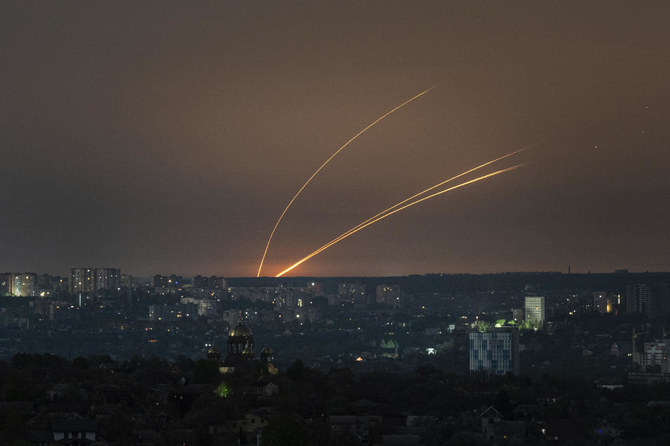
- Fifty drones were shot down by air defenses over eight Russian regions, including 26 over the country’s western Belgorod region
- Russia’s Defense Ministry said that it had shot down a Ukrainian Sukhoi Su-25 fighter jet
KYIV: Ukraine launched a barrage of drones across Russia overnight, the Defense Ministry in Moscow said Saturday, in attacks that appeared to target the country’s energy infrastructure.
Fifty drones were shot down by air defenses over eight Russian regions, including 26 over the country’s western Belgorod region close to the Ukrainian border. Two people — a woman with a broken leg and the man caring for her — died during the overnight barrage, after explosions sparked a blaze that set their home alight, Belgorod Gov. Vyacheslav Gladkov wrote on social media. A pregnant woman and her unborn child were also killed in shelling later Saturday, he said.
Drones were also reportedly destroyed over the Bryansk, Kursk, Tula, Smolensk, Ryazan, Kaluga regions across Russia’s west and south, as well as in the Moscow region.
Russia’s Defense Ministry said that it had shot down a Ukrainian Sukhoi Su-25 fighter jet. It provided no details and the claims could not be independently verified.
Ukrainian officials normally decline to comment about attacks on Russian soil. However, many of the drone strikes appeared to be directed toward Russia’s energy infrastructure.
The head of the Kaluga region, Vladislav Shapsha, said Saturday that a drone strike had sparked a blaze at an electrical substation, while Bryansk Gov. Alexander Bogomaz and Smolensk Gov. Vasily Anokhin also reported fires at fuel and energy complexes.
In recent months, Russian refineries and oil terminals have become priority targets of Ukrainian drone attacks, part of stepped-up assaults on Russian territory.
Ukrainian drone developers have been extending the weapons’ range for months, as Kyiv attempts to compensate for its battlefield disadvantage in weapons and troops. The unmanned aerial vehicles are also an affordable option while Ukraine waits for more US military aid.
Moscow also said Friday evening that an American citizen known to have fought with Kremlin-backed separatists in Ukraine between 2014 and 2017 had died in the Russian-occupied Donetsk region.
Russell Bentley, 64, was no longer involved in military operations and previously worked for state-owned Russian news agency Sputnik. His death was confirmed by his former battalion and by Margarita Simonyan, head of the state-funded television channel RT, who described him as “a real American.” He used the call-sign “Texas” and had spent time in prison on charges of drug smuggling before leaving the United States.
No information has been released as to the cause of Bentley’s death, but local police had previously reported the American as missing on April 8.
Meanwhile, Russia attacked Ukraine overnight with seven missiles, and air defenses downed two missiles and three reconnaissance drones, the Ukrainian air force said Saturday.
Gov. Oleh Kiper, head of Ukraine’s Odesa region, said that ballistic missiles had damaged infrastructure overnight, but did not provide further details. Previous attacks on the Black Sea city on Friday damaged port infrastructure, including two food export terminals, Ukrainian President Volodymyr Zelensky said.
Russian shelling also killed two men, including an 81-year-old pensioner in the city of Vovchansk, said Gov. Oleh Syniehubov, head of Ukraine’s Kharkiv region.
A 60-year-old woman was also injured after shelling struck a nine-story apartment block, he said.
Efforts underway to bring home Filipinos killed in UAE floods
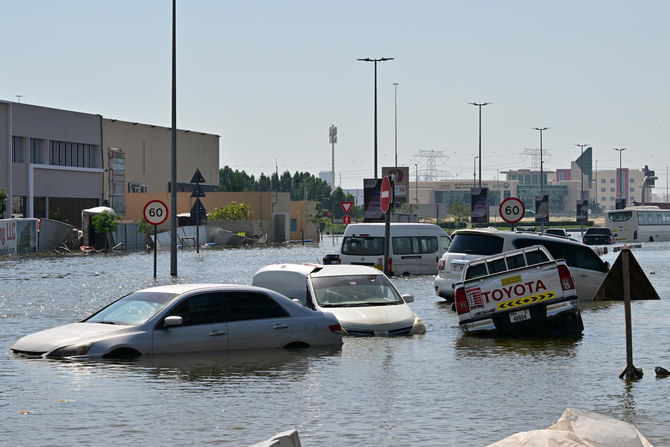
- At least three Filipinos lost their lives in the unprecedented flooding
- Philippine consulate received assistance requests from at least 100 Filipinos
Manila: The Philippine government is assisting Filipinos affected by the record-high rains and flooding that hit the UAE this week, authorities said on Saturday, as it works to repatriate the nationals who lost their lives.
A strong storm first hit Oman last weekend, killing at least 20 people, before it pounded the UAE on Tuesday, marking the heaviest rains in 75 years and bringing the Gulf state to a standstill.
The Philippine Department of Migrant Workers has confirmed the deaths of at least three Filipinos who died in road accidents as their vehicles were submerged in floodwaters.
Philippine Consul General Marford Angeles told Arab News the consulate had received assistance requests from at least 100 Filipinos — some working in the UAE, some studying, and some transiting via Dubai.
“Over 1 million Filipino nationals are currently residing in the UAE ... Majority of assistance requests received by the consulate so far originate from the populous emirates of Dubai and Sharjah, reflecting the concentration of Filipino residents in these areas,” he said.
“The unprecedented weather conditions in the UAE affected most residents.”
The three Filipinos who lost their lives in the floods were two women who died inside their flooded vehicle, and a man who died after sustaining major injuries when his vehicle fell into a sinkhole. His two passengers have been hospitalized.
“The Department of Migrant Workers, through its Migrant Workers Offices in Dubai and Abu Dhabi, is working with local authorities for the repatriation of the remains of three overseas Filipino workers (OFWs) who died during the severe flooding,” the DMW said in a statement.
“Two other OFWs, both male, suffered injuries from the vehicular accident that happened in the sinkhole. They are recuperating from their injuries.”
US House to vote on long-awaited $95 billion Ukraine, Israel aid package

- Some hard-line Republicans have voiced strong opposition to further Ukraine aid
WASHINGTON: The Republican-controlled US House of Representatives on Saturday is set to vote on, and expected to pass, a $95 billion legislative package providing security assistance to Ukraine, Israel and Taiwan, over bitter objections from party hard-liners.
More than two months have passed since the Democratic-majority Senate passed a similar measure and US leaders from Democratic President Joe Biden to top Senate Republican Mitch McConnell have been urging embattled House Speaker Mike Johnson to bring it up for a vote.
Johnson this week chose to ignore ouster threats by hard-line members of his fractious 218-213 majority and push forward the measure that includes some $60.84 billion for Ukraine as it struggles to fight off a two-year Russian invasion.
The unusual four-bill package also includes funds for Israel, security assistance for Taiwan and allies in the Indo-Pacific and a measure that includes sanctions, a threat to ban the Chinese-owned social media app TikTok and the potential transfer of seized Russian assets to Ukraine.
“The world is watching what the Congress does,” the White House said in a statement on Friday. “Passing this legislation would send a powerful message about the strength of American leadership at a pivotal moment. The Administration urges both chambers of the Congress to quickly send this supplemental funding package to the President’s desk.”
A bipartisan 316-94 House majority on Friday voted to advance the bill to a vote, and Senate Majority Leader Chuck Schumer told senators to be ready to work over the weekend if it passes the House as expected.
“It’s not the perfect legislation, it’s not the legislation that we would write if Republicans were in charge of both the House, the Senate, and the White House,” Johnson told reporters on Friday. “This is the best possible product that we can get under these circumstances to take care of these really important obligations.”
Some hard-line Republicans have voiced strong opposition to further Ukraine aid, with some arguing the US can ill afford it given its rising $34 trillion national debt. They have repeatedly raised the threat of ousting Johnson, who became speaker in October after his predecessor, Kevin McCarthy, was ousted by party hard-liners.
Representative Bob Good, chair of the hard-line House Freedom Caucus, told reporters on Friday that the bills represent a “slide down into the abyss of greater fiscal crisis and America-last policies that reflect Biden and Schumer and (House Democratic leader Hakeem) Jeffries, and don’t reflect the American people.”
But Republican presidential candidate Donald Trump, who carries huge influence in the party, on April 12 voiced support for Johnson and in a Thursday social media post said Ukraine’s survival is important for the US
The bills provide $60.84 billion to address the conflict in Ukraine, including $23 billion to replenish US weapons, stocks and facilities; $26 billion for Israel, including $9.1 billion for humanitarian needs, and $8.12 billion for the Indo-Pacific.




